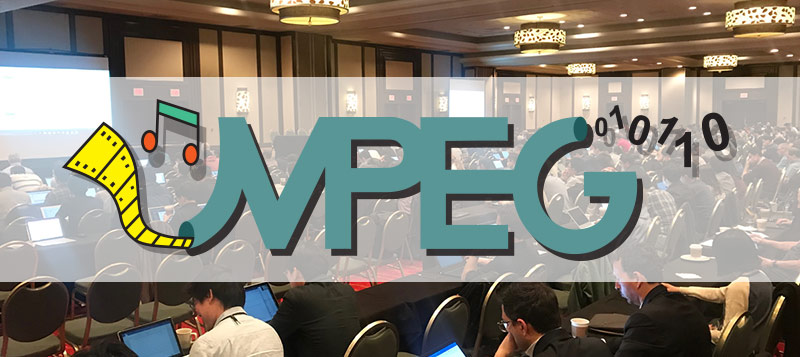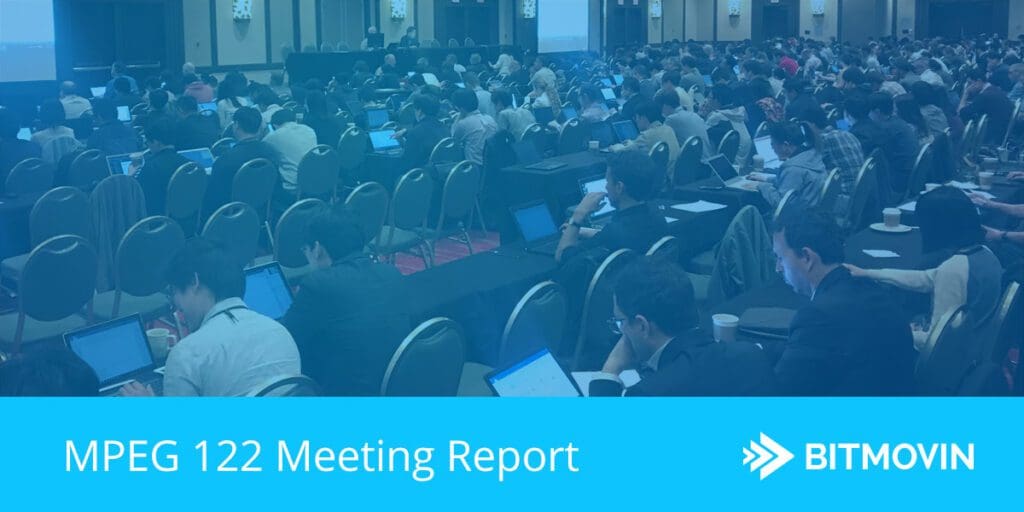
The 122nd MPEG meeting concluded on April 20, 2018 in San Diego, CA, USA with the following topics:
- Versatile Video Coding (VVC) project starts strongly in the Joint Video Experts Team
- MPEG issues Call for Proposals on Network-based Media Processing
- MPEG finalizes 7th edition of MPEG-2 Systems Standard
- MPEG enhances ISO Base Media File Format (ISOBMFF) with two new features
- MPEG-G standards reach Draft International Standard for transport and compression technologies
The corresponding press release of the 122nd MPEG meeting can be found here: http://mpeg.chiariglione.org/meetings/122
Versatile Video Coding (VVC) – MPEG’ & VCEG’s new video coding project starts strong
The Joint Video Experts Team (JVET), a collaborative team formed by MPEG and ITU-T Study Group 16’s VCEG, commenced work on a new video coding standard referred to as Versatile Video Coding (VVC). The goal of VVC is to provide significant improvements in compression performance over the existing HEVC standard (i.e., typically twice as much as before) and to be completed in 2020. The main target applications and services include — but not limited to — 360-degree and high-dynamic-range (HDR) videos. In total, JVET evaluated responses from 32 organizations using formal subjective tests conducted by independent test labs. Interestingly, some proposals demonstrated compression efficiency gains of typically 40% or more when compared to using HEVC. Particular effectiveness was shown on ultra-high definition (UHD) video test material. Thus, we may expect compression efficiency gains well-beyond the targeted 50% for the final standard.
VVC is obviously the new kid on the block in addition to those formats used today as well as those considered in the near future, i.e., AVC, HEVC, VP9 and the new AV1 video codec. In 2017 we have conducted a video developer survey and it would be interesting how VVC will be noticed within the video developer community. Recently, we published a multi-codec DASH dataset arguing for efficient support of multiple video codecs, which we see confirmed with the appearance of VVC.
MPEG issues Call for Proposals on Network-based Media Processing
This Call for Proposals (CfP) addresses advanced media processing technologies such as network stitching for VR service, super resolution for enhanced visual quality, transcoding, and viewport extraction for 360-degree video within the network environment that allows service providers and end users to describe media processing operations that are to be performed by the network. Therefore, the aim of network-based media processing (NBMP) is to allow end user devices to offload certain kinds of processing to the network. Therefore, NBMP describes the composition of network-based media processing services based on a set of media processing functions and makes them accessible through Application Programming Interfaces (APIs). Responses to the NBMP CfP will be evaluated on the weekend prior to the 123rd MPEG meeting in July 2018.
MPEG Systems News
7th edition of MPEG-2 Systems Standard
More than 20 years since its inception development of MPEG-2 systems technology (i.e., transport/program stream) continues. New features include support for: (i) JPEG 2000 video with 4K resolution and ultra-low latency, (ii) media orchestration related metadata, (iii) sample variance, and (iv) HEVC tiles.
ISO Base Media File Format (ISOBMFF) with two new features
The partial file format enables the description of an ISOBMFF file partially received over lossy communication channels. This format provides tools to describe reception data, the received data and document transmission information such as received or lost byte ranges and whether the corrupted/lost bytes are present in the file and repair information such as location of the source file, possible byte offsets in that source, byte stream position at which a parser can try processing a corrupted file. Depending on the communication channel, this information may be setup by the receiver or through out-of-band means.
Sample variants (2nd edition), which are typically used to provide forensic information in the rendered sample data that can, for example, identify the specific Digital Rights Management (DRM) client which has decrypted the content. This variant framework is intended to be fully compatible with MPEG’s Common Encryption (CENC) and agnostic to the particular forensic marking system used.
MPEG-2 transport stream and ISO base media file format are fundamental formats for HTTP adaptive streaming (HAS), specifically DASH and HLS! Both formats are fully supported within Bitmovin’s encoding and player offerings.
MPEG-G standards reach Draft International Standard for transport and compression technologies
MPEG-G provides a set of standards enabling interoperability for applications and services dealing with high-throughput deoxyribonucleic acid (DNA) sequencing. At its 122nd meeting, MPEG promoted its core set of MPEG-G specifications, i.e., transport and compression technologies, to Draft International Standard (DIS) stage. Such parts of the standard provide new transport technologies (ISO/IEC 23092-1) and compression technologies (ISO/IEC 23092-2) supporting rich functionality for the access and transport including streaming of genomic data by interoperable applications. Reference software (ISO/IEC 23092-4) and conformance (ISO/IEC 23092-5) will reach this stage in the next 12 months.
WHAT ELSE HAPPENED at MPEG122?
- Requirements is exploring new video coding tools dealing with low-complexity and process enhancements.
- The activity around coded representation of neural networks has defined a set of vital use cases and is now calling for test data to be solicited until the next meeting.
- The MP4 registration authority (MP4RA) has a new awesome web site http://mp4ra.org/.
- MPEG-DASH is finally approving and working the 3rd edition comprising consolidated version of recent amendments and corrigenda.
- CMAF started an exploration on multi-stream support, which could be relevant for tiled streaming and multi-channel audio.
- OMAF kicked-off its activity towards a 2nd edition enabling support for 3DoF+ and social VR with the plan going to committee draft (CD) in Oct’18. Additionally, there’s a test framework proposed, which allows to assess performance of various CMAF tools. Its main focus is on video but MPEG’s audio subgroup has a similar framework to enable subjective testing. It could be interesting seeing these two frameworks combined in one way or the other.
- MPEG-I architectures (yes plural) are becoming mature and I think this technical report will become available very soon. In terms of video, MPEG-I looks more closer at 3DoF+ defining common test conditions and a call for proposals (CfP) planned for MPEG123 in Ljubljana, Slovenia. Additionally, explorations for 6DoF and compression of dense representation of light fields are ongoing and have been started, respectively.
- Finally, point cloud compression (PCC) is in its hot phase of core experiments for various coding tools resulting into updated versions of the test model and working draft.
Did we miss something? Maybe yes, feel free to contact us…
Finally, on May 10 MPEG will celebrate 30 years as its first meeting dates back to 1988 in Ottawa, Canada with around 30 attendees. The 122nd meeting had more than 500 attendees and MPEG has around 20 active work items. A total of more than 170 standards have been produces (that’s approx. six standards per year) where some standards have up to nine editions like the HEVC standards. Overall, MPEG is responsible for more that 23% of all JTC 1 standards and some of them showing extraordinary longevity regarding extensions, e.g., MPEG-2 systems (24 years), MPEG-4 file format (19 years), and AVC (15 years). MPEG standards serve billions of users (e.g., MPEG-1 video, MP2, MP3, AAC, MPEG-2, AVC, ISOBMFF, DASH). Some — more precisely five — standards have receive Emmy awards in the past (MPEG-1, MPEG-2, AVC (2x), and HEVC).
Thus, happy birthday MPEG! In today’s society starts the high performance era with 30 years, basically the time of “compression”, i.e., we apply all what we learnt and live out everything, truly optimistic perspective for our generation X (millennials) standards body!




